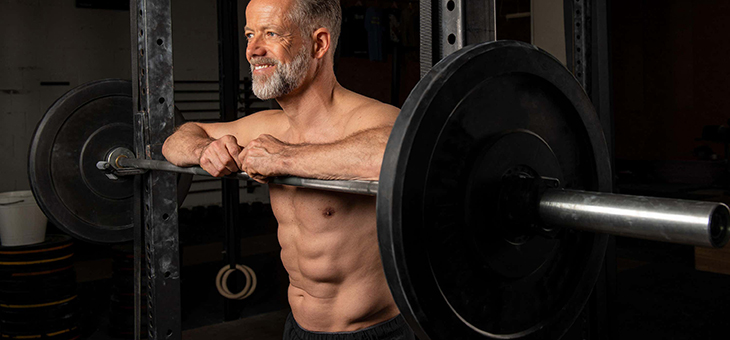Achieving a chiselled six-pack is the Holy Grail for many dedicated gym-goers, but the challenge can become harder the older you get.
As you age, you lose muscle mass and your body becomes less efficient in converting food into energy – a process that leads to the well-documented ‘middle-aged spread’ that often happens after you turn 40, even if your lifestyle and diet remain the same.
“By the time you hit your 40s, unless you’ve stuck to a regular weight training program since your 20s, your muscle mass will have been in a state of persistent decline for a long time,” says personal trainer Ruth Stone. “Getting a six-pack is not impossible, but requires an incredible effort.”
Read: Age at which your metabolism starts slowing is later than you think
Thankfully, if you’re already in decent shape, just a few changes to your routine can put you on the right path. To that end, we asked Ms Stone, and Nicola Addison-Newland, Healthspan’s resident personal trainer, for their best tips and tricks for sculpting a shredded six-pack.
1. Be strategic with diet and exercise
“To achieve a six-pack, you’ll need a low-calorie, high-protein diet coupled with a training program that includes core strength exercises at least three times a week,” says Ms Stone. “To make the body leaner, a low-calorie diet coupled with regular general exercise is a must. You’re more likely to improve your muscle-to-fat ratio if you have a HIIT session at least twice a week, to improve your overall fitness, and weight sessions at least three times a week to build your muscle mass.
Read: Why strength training is critical
“Together, these two factors will reduce your fat deposits, increase your overall muscle mass, increase your ability to exercise harder as you get fitter and, most importantly, increase your metabolism – meaning your body will require more calories to operate, both during periods of rest and exercise, which will continue to drive down your stored fat.”
2. Focus on core exercises
“In terms of core conditioning, there are lots of exercises that you can do, but those that involve extra weight in addition to your own body weight will be the most effective at creating tone and definition in the abdominal region,” says Ms Stone. “These should always be balanced with an equal number of back exercises that require just as much effort – these will keep your training balanced and operate to sustain posture, which is important if the appearance of the muscle is as important as its function to you.”
“Don’t be scared to lift weights and lift heavy,” adds Ms Addison. “Muscle is metabolically active, burning energy even when at rest, meaning you will carry on burning calories post-workout and far into the next day if you eat right.”
3. Add in compound movements
“Studies have shown that regular weight training can boost your basal metabolic rate by 15 per cent,” notes Ms Addison. “Make sure to incorporate exercises that challenge numerous muscle groups and multiple joints, also known as compound movements, into your workout routine. These include squats, lunges, pull-ups, deadlifts, and bent-over rows.”
4. Always eat breakfast
“Skipping breakfast slows down your metabolism as your body adjusts to cling on to any nutrients and calories it can find,” says Ms Addison. “Eat breakfast like a king, lunch like a prince and dinner like a pauper, making sure that protein is the base of meals.”
Read: Things that happen when you overhaul your diet
5. Get in 5000 steps before lunch
“Staying active outside of the gym can help keep your midsection lean, and walking instead of taking the car is a great way to do this. Just 10 minutes of walking equates to around 1000 steps,” says Ms Addison.
“Guidelines suggest that the average adult should complete 10,000 steps a day (equating to 150 minutes of activity each week). Achieving half of our steps before lunch is a great way to burn calories and keep on track with fitness goals.”
Have you ever had a six-pack? Did you notice your muscle mass declining after 40? Why not share your exercise tips in the comments section below?
– With PA
If you enjoy our content, don’t keep it to yourself. Share our free eNews with your friends and encourage them to sign up.

